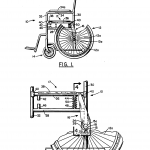Wheelchair dancing seems to becoming more and more popular and for those who are not familiar involves dance between one able bodied partner and one wheelchair user, the results are often quite spectacular when a well practiced couple take to the floor - with non marking tyres of course.
There has been a lot in the news about the wheelchair user who has been banned from the dance floor due to the worry of his tyres marking the precious wooden floor and as per normal it has erupted in to more of a debate on equality and discrimination which has led one individual to sue a certain company after he was banned from an event over claims his wheelchair damaged the dance floor.
Mr Waldon who hails from Oxford has been a paraplegic since an accident back in 1984, prior to that he had been a keen dancer who preferred disco and Northern Soul music to dance to. About 15 years ago he started to dance using his wheelchair and it has become a large and important part of his life which now takes him up and down the country attending jive, blues and swing dance events and competitions. Fred comments:
"I think if I hadn't found jive dancing I would probably be dead," he said.
"It's very easy if you are paralysed to put on a lot of weight, especially in the winter when I used to suffer chronic chest and kidney infections. With dancing, as well as getting the exercise, I get out and meet lots of really, really lovely people."
In October, Jive Addiction Limited organised an event in a London hotel which is where all the commotion started. Fred was asked to stop his wheelchair dancing as the staff believed his wheelchair tyres were causing damage to the dance floor. This had never occurred previously and Mr Waldon thought they were joking to begin with.
"I was taken to an area of the dance floor I hadn't been on and shown a black scuff mark which rubbed off easily," he said.
"I explained that my wheelchair has been specially constructed for dancing with able-bodied partners and was fitted with wheelchair sports tyres that are specially made not to leave marks."
"I felt anger and embarrassment because I am there with people I want to dance with," he said.
The evening went badly wrong from there on in for Fred who was not only prevented from enjoying his wheelchair dancing but says that he was also made to feel like a vandal. So as a result, Mr Walden is suing Jive Addiction for discrimination under the Equality Act 2010, claiming that the company acted in breach of its obligations under the Equality act, an order that it should comply with its obligations, and damages for injury to his feelings - which is of course very hard to quantify.
Although Jive Addiction Ltd has not made a statement however its terms to include a line that prevents anyone damaging the dance floor with any object, and denies that it is discriminatory, however, Mr Walden's solicitor, Chris Fry from Unity Law, disputes this.
He said: "It's a fundamental misunderstanding about the Equality Act that having a policy which treats everybody the same is compliant. It isn't.
"The act encourages companies to think about the outcome of that policy.
"If you have a policy which says wheelchair users are not allowed on a dance floor, then essentially you are preventing disabled people from participating in this activity. "It's a breach of the Equality Act because it's discriminatory."
It is a shame when this sort of thing occurs and it’s not only wheelchair users who suffer under this act. So far, Mr Walden has received many letters of support other companies that put on dance events here in the UK and is determined to see his legal battle to a satisfactory conclusion early in 2017. Of course, In the meanwhile Mr Walden continues with his wheelchair dancing.




















